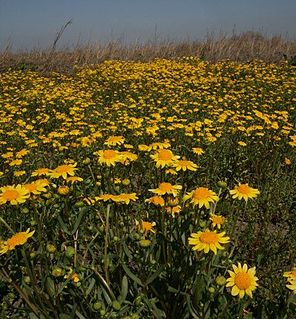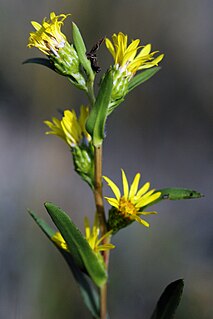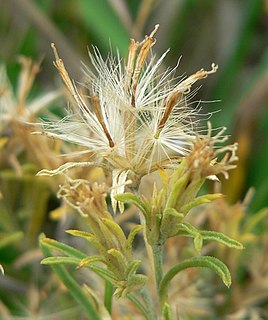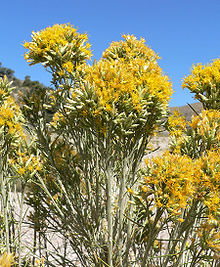Senecio lamarckianus, the bois de chèvre, is a species of flowering plant in the aster family and a member of the genus Senecio. It is endemic to the island of Mauritius and is threatened by habitat loss.

Coreopsis calliopsidea is a species of flowering plant in the daisy family known by the common name leafstem tickseed. It is endemic to California. The plant grows in some of the southern coastal mountain ranges and Transverse Ranges and the Mojave Desert from Alameda and Inyo Counties south to Riverside County.

Ericameria laricifolia is a North American species of flowering shrub in the daisy family known by the common name turpentine bush, or turpentine-brush. It is native to the southwestern United States and northern Mexico (Chihuahua).
Senecio maranguensis a 2-meter (6 foot) woody shrub
or 6 meter (20 feet) climbing shrub from the family Asteraceae and species of the genus Senecio
which makes its home at the same altitudes as the bamboo on the slopes of the mountains in East Africa.
Lasthenia chrysantha is a species of flowering plant in the daisy family known by the common name alkalisink goldfields. It is endemic to the California Central Valley, where it grows in vernal pools and alkali flats.

Lasthenia ferrisiae is a species of flowering plant in the daisy family known by the common name Ferris' goldfields. It is endemic to the California Central Valley, where it grows in vernal pools and alkali flats.
Lasthenia glaberrima is a species of flowering plant in the daisy family known by the common names smooth goldfields and rayless goldfields. It is native to western North America from British Columbia to California, where it grows in wet places such as vernal pools and springtime meadows.
Ericameria greenei is a species of flowering shrub in the daisy family known by the common name Greene's goldenbush. It is native to the mountains of the western United States in Washington, Idaho, Oregon, and the northern California as far south as Lake and Tuolumne Counties.

Phaneroglossa is a genus of plants that is assigned to the daisy family. The genus currently consist of only one species, Phaneroglossa bolusii, a perennial plant of up to 40 cm high, that has leathery, line- to lance-shaped, seated leaves with mostly few shallow teeth and flower heads set individually on top of long stalks. The flower head has an involucre of just one whorl of bracts, few elliptic, white or cream ray florets, and many yellow disc florets. It is an endemic species of the Western Cape province of South Africa. Flowering mainly occurs from November to January.

Porophyllum gracile is a species of flowering plant in the aster family known by the common names odora and slender poreleaf. It is native to northern Mexico and the southwestern United States from California to Texas, where it can be found in rocky and sandy desert scrub habitat.

Grindelia ciliata is a species of flowering plant in the daisy family known by the common names Spanish gold, goldenweed, and waxed goldenweed.

Pyrrocoma apargioides is a species of flowering plant in the aster family known by the common name alpineflames. It is native to the western United States from the Sierra Nevada of California east to Utah, where it grows in the forests and meadows of high mountains. It is a perennial herb growing from a taproot and producing one or more stems to 30 centimeters in length. The stems are decumbent or upright, reddish, and hairless to slightly woolly. Most of the leaves are located around the base. They are thick and leathery, lance-shaped with large sawteeth along the edges, often center-striped in white, and measure up to 10 centimeters long. The inflorescence is usually a single flower head lined with centimeter-long phyllaries which are reddish to green with red edges. The head has a center of yellow disc florets and a fringe of ray florets which are yellow, often splashed with red along the undersides, measuring up to 1.6 centimeters in length. The fruit is an achene which may be well over a centimeter in length including its pappus.
Pyrrocoma lucida is a species of flowering plant in the aster family known by the common names sticky goldenweed and sticky pyrrocoma. It is endemic to California, where it is known only from the northern Sierra Nevada. It grows in mountain forests and clay flats with alkali soils. This is a perennial herb growing from a taproot, producing an erect stem up to 75 centimetres (30 in) tall. It is hairless and glandular, its surface resinous and shiny. The leaves are lance-shaped with sharply toothed edges, the largest near the base of the stem reaching 25 centimetres (10 in) in length. Smaller leaves up to 10 centimetres (4 in) long occur higher on the stem. The inflorescence is a narrow spikelike array of many flower heads lined with thick, overlapping, gland-dotted phyllaries. Each head contains up to 40 yellow disc florets surrounded by a fringe of up to 20 yellow ray florets. The fruit is an achene up to a centimeter long including its pappus.

Pyrrocoma racemosa is a species of flowering plant in the aster family known by the common name clustered goldenweed. It is native to the western United States, where it grows in many types of habitat. It is quite variable in morphology, and there are several varieties which are sometimes hard to tell apart. In general, it is a perennial herb usually producing two or more mostly erect stems reaching maximum heights between 15 and 90 centimeters. The stems are reddish or brownish in color, leafy or not, and hairless to quite woolly. The longest leaves are located in tufts around the base of the stems. They are lance-shaped to oval, smooth-edged, wavy, or deeply spine-toothed, and may exceed 30 centimeters in length. Basal leaves are borne on woolly petioles. Leaves located higher on the stem lack petioles and may clasp the stem at their bases. The inflorescence is a cluster of several flower heads lined with phyllaries which may be over a centimeter long and are hairy to hairless in texture. Each head contains many yellow disc florets and a fringe of several yellow ray florets. The fruit is an achene which may be over a centimeter long including its pappus.
Senecio aronicoides is a species of flowering plant in the aster family known by the common name rayless ragwort. It is native to Oregon and northern and central California, where it can be found in the woodlands and forests of mountains and foothills, often in relatively dry habitat. It is a biennial or perennial herb growing up to about 90 centimeters tall from a fleshy root attached to a buttonlike caudex. The plant is often slightly woolly or cobwebby in texture. The leaves have lance-shaped to oval blades measuring up to 20 centimeters long, the largest ones lower on the stem. The inflorescence is a corymb which is flat and spreading, often resembling an umbel. The flower heads are cups lined with black- or green-tipped phyllaries and filled with many gold disc florets. There are usually no ray florets but one or two occasionally emerge from a head. The fruit is a hairless achene tipped with a pappus of long, white bristles.
Xylorhiza orcuttii is a perennial plant in the aster family known by the common name Orcutt's aster. It is native to southern California and northern Baja California, where it grows in scrubby habitat in the dry canyons of the Sonoran Desert. It often grows in rocky and sandy substrates, clay, and alkaline soils amongst cactus. It is a shrub with branching, mostly hairless stems that may reach 1.5 meters in length. The leaves are lance-shaped to oblong with smooth, toothed, or spiny edges. The inflorescence is a solitary flower head with up to 40 or more lavender or pale blue ray florets, each of which may measure over 3 centimeters in length. Flowering may begin as early as late fall or winter. The fruit is an achene which may be over a centimeter long, including its pappus of bristles.

Acamptopappus spaerocephalus is a species of flowering plant in the aster family known by the common name rayless goldenhead. It is native to the southwestern United States, where it occurs in southern California, southern Nevada, southern Utah, and Arizona.

Ericameria parryi is a species of flowering plant in the aster family known by the common name Parry's rabbitbrush. It is native to much of the western United States.

Felicia nordenstamii is a flowering shrub in the daisy family, Asteraceae. It is found only in South Africa where it grows on limestone hills close to the sea on the southern coast. Felicia nordenstamii is a many-branched shrub growing up to 30 cm (1 ft) tall. The lower parts of the stems are covered in grayish brown bark and the upper stem has many crowded, upwardly angled, alternate leaves with long hairs on the lower surfaces. Large flower heads form at the tips of the branches, each about 41⁄2 cm across, with about thirty purplish blue ray florets surrounding many yellow disc florets.
Felicia westae is a sparsely branched shrub growing up to 40 cm tall, that is assigned to the daisy family. The lower parts of the stems have lost their leaves and the upper part has many crowded, upwardly angled and curved, alternate leaves pressed against the stem, with the edges curled inward. The flower heads form at the tips of the branches, each about 31⁄3 cm across, with about twenty purplish blue ray florets surrounding many yellow disc florets. It is only known from a small area in the Eastern Cape province of South Africa.














